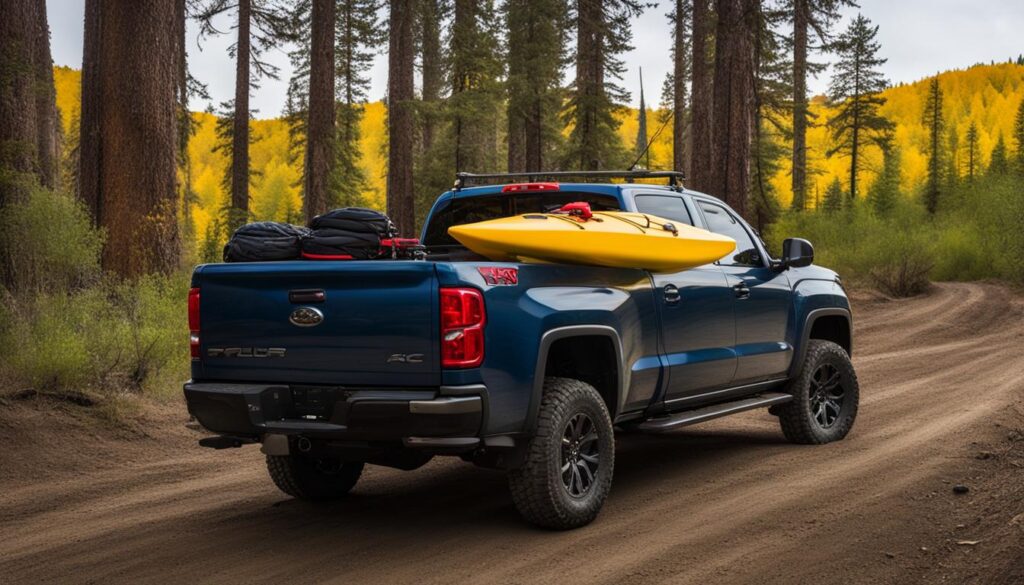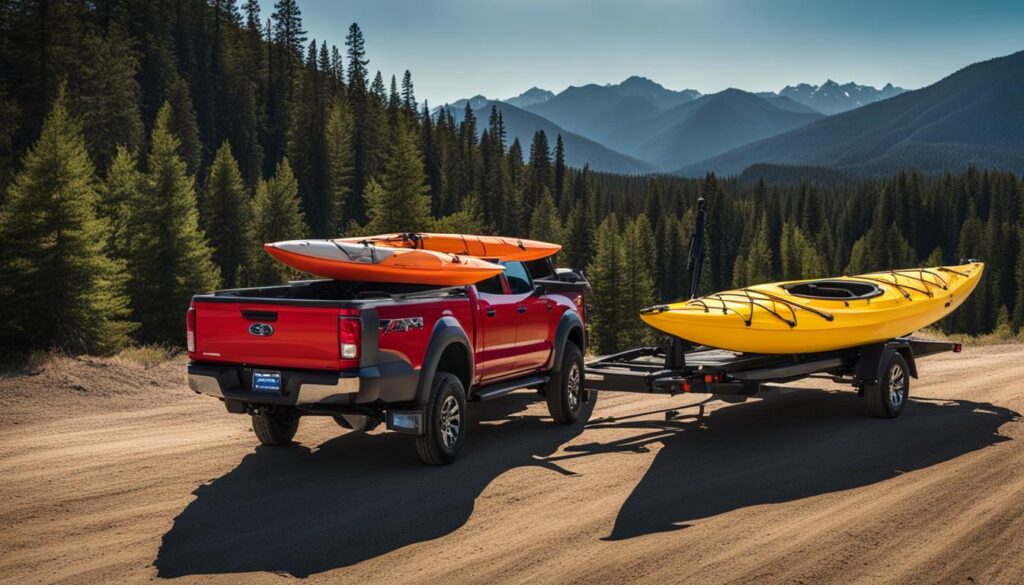Knowing how to properly transport a kayak is essential for any kayak owner. In this article, we will explore various methods and solutions for easy and safe kayak transportation. Whether you’re new to kayaking or looking for alternative transport options, we’ve got you covered.
Carrying a kayak can be a challenge, especially if you’re not familiar with the right techniques. That’s why we’ll provide step-by-step instructions and valuable tips on how to carry a kayak with ease. Whether you’re carrying it on your own or with a partner, we’ll show you the best methods to ensure a safe and hassle-free experience.
If you have a roof rack on your vehicle, transporting your kayak becomes a breeze. We’ll delve into different types of roof racks, such as J-style racks, saddle racks, stacker racks, and temporary pads, that can securely hold your kayak in place during transit. We’ll also discuss the essential accessories you’ll need, like crossbars, cam straps, and bow and stern lines, for a secure and stress-free journey.
Not everyone has a roof rack, but that doesn’t mean you can’t transport your kayak. We’ll explore alternative options, such as using a pickup truck or a tow hitch, to conveniently transport your kayak without a roof rack. Additionally, we’ll discuss the option of inflatable kayaks and other vehicle types, like SUVs or vans, that can accommodate your kayak without the need for specialized equipment.
Finally, we’ll provide you with essential tips for tying down your kayak during transportation. Properly securing your kayak is crucial for both your safety and the integrity of your kayak. We’ll cover techniques like the trucker’s hitch and share valuable tips on keeping your kayak secure throughout the entire journey.
Whether you’re planning a weekend adventure or simply need to transport your kayak to a nearby lake, this article will equip you with all the necessary knowledge and solutions for easy and safe kayak transportation. Get ready to hit the water with confidence!
Carrying a Kayak: Tips and Techniques
When it comes to transporting your kayak, knowing how to properly carry it is essential for a smooth and hassle-free experience. Whether you’re a solo paddler or have a friend to assist you, here are some tips and techniques to ensure you carry your kayak safely and efficiently.
Carrying with Two People:
If you have a partner to help you, carrying a kayak becomes much easier. Start by positioning yourselves on opposite sides of the kayak, with one person at the bow (front) and the other at the stern (back). Both of you should bend your knees slightly and lift the kayak together, making sure to keep your backs straight and using your leg muscles for support. Communication is key during this process, so coordinate your movements to ensure a balanced and controlled carry.
Solo Carrying Tips:
Carrying a kayak by yourself may seem challenging, but with the right technique, it’s definitely doable. Begin by positioning the kayak parallel to your body, resting it on your shoulder. Make sure to distribute the weight evenly and maintain a firm grip on both the kayak and the kayak’s grab handles or cockpit rim. Walk slowly and cautiously, keeping your back straight and using your core muscles to stabilize the kayak. If the kayak feels too heavy, take breaks as needed to avoid straining yourself.
Helpful Accessories:
In addition to proper carrying techniques, there are several accessories that can make the process even easier. Consider investing in a kayak cart, which allows you to roll your kayak instead of carrying it. This is especially useful for longer distances or rough terrain. Furthermore, don’t forget to wear a personal flotation device (PFD) while carrying your kayak. It not only ensures your safety but also provides added buoyancy in case of accidental slips or falls.
By mastering the art of carrying your kayak and utilizing helpful accessories, you can transport your kayak with confidence and ease. Whether you’re embarking on a solo adventure or heading out with friends, following these tips and techniques will ensure that your kayak transportation experience is a breeze.
Transporting a Kayak with a Roof Rack
When it comes to transporting your kayak, using a roof rack system is one of the easiest and most popular methods. A roof rack provides a secure and stable platform for your kayak, allowing you to safely transport it to your desired location. There are different types of roof racks available, each with its own advantages and considerations.
One type of roof rack is the J-style rack, which holds your kayak in a cradle-like position. This rack is ideal for solo kayakers as it allows for easy loading and unloading. Another option is the saddle rack, which features padded bars that support the kayak along its length. This type of rack is suitable for both solo and tandem kayaks.
For those who need to transport multiple kayaks, a stacker rack can be a great choice. A stacker rack allows you to stack two or more kayaks on top of each other, maximizing your roof space. If you don’t want to install a permanent roof rack, temporary pads can be a convenient alternative. These pads can be easily attached to the roof of your vehicle and provide a padded surface for your kayak to rest on.
Essential Accessories for Roof Rack Transportation
- Crossbars: Crossbars are the foundation of your roof rack system. They provide the base for attaching other rack components and securely holding your kayak in place.
- Cam Straps: Cam straps are essential for securing your kayak to the roof rack. These straps have a buckle mechanism that allows for easy tightening and ensures a tight and secure hold.
- Bow and Stern Lines: Bow and stern lines are used to further secure your kayak to the roof rack and prevent it from shifting during transportation. These lines attach to the front and back of your kayak and anchor it to the vehicle.
With the right roof rack system and accessories, transporting your kayak becomes a breeze. Make sure to choose a roof rack that fits your vehicle and kayak properly, and always double-check the security of your kayak before hitting the road. Now that you’re familiar with the benefits and considerations of using a roof rack, you can confidently transport your kayak to your next adventure.
Transporting a Kayak with a Pickup Truck
If you don’t have a roof rack or prefer not to use one, transporting a kayak with a pickup truck is a convenient alternative. With the right equipment and proper techniques, you can securely transport your kayak without the need for a roof rack.
One popular method of transporting a kayak in a pickup truck is by using tailgate pads. These pads are specifically designed to fit over the tailgate, providing a soft and secure platform for your kayak. Simply strap the pad to the tailgate, place your kayak on top, and secure it with straps or bungee cords. This method is ideal for those who have multiple kayaks or want to transport other equipment along with their kayak.
Another option for pickup truck transport is using a kayak rack that attaches to the truck bed. These racks are usually adjustable and can accommodate different kayak sizes. They provide a stable and secure solution for transporting your kayak. Simply load your kayak onto the rack, secure it with straps, and you’re ready to go.
Key points for transporting a kayak with a pickup truck:
- Use tailgate pads or a kayak rack for secure transport
- Make sure the kayak is properly secured with straps or bungee cords
- Check the straps periodically during the journey to ensure they are tight and secure
- Take into consideration the weight limit of your pickup truck and adjust accordingly
Transporting a kayak with a pickup truck offers flexibility and convenience, allowing you to easily transport your kayak without the need for a roof rack. Whether you choose tailgate pads or a kayak rack, make sure to follow proper securing techniques to ensure a safe and hassle-free journey.
Transporting a Kayak with a Tow Hitch
If you don’t have a roof rack or prefer not to use one, transporting your kayak with a tow hitch is a great alternative. By utilizing a kayak trailer hitch, you can securely transport your kayak without worrying about it shifting or falling off during the journey.
A kayak trailer hitch is a specialized attachment that connects to your vehicle’s tow hitch. It provides a stable platform for your kayak and ensures safe and hassle-free transportation. To secure your kayak to the trailer, make sure to use high-quality kayak transport straps that are specifically designed for this purpose. These straps are strong, durable, and have adjustable buckles to ensure a tight and secure fit.
When using a tow hitch for kayak transportation, it’s important to follow a few key steps. First, ensure that the trailer hitch is properly connected to your vehicle and securely fastened. Next, position your kayak on the trailer, making sure it is centered and balanced. Then, use the kayak transport straps to secure the kayak to the trailer, ensuring that it is tightly strapped down and cannot move around.
Key Points:
- Transporting a kayak with a tow hitch is a convenient alternative to using a roof rack.
- Use a kayak trailer hitch attachment that connects to your vehicle’s tow hitch for stability.
- Secure your kayak to the trailer using high-quality kayak transport straps with adjustable buckles.
- Ensure the trailer hitch is properly connected and secure before loading your kayak onto the trailer.
- Position your kayak on the trailer, centering and balancing it before strapping it down tightly.
Transporting your kayak with a tow hitch and kayak trailer provides a reliable and secure method for transportation. It allows you to easily take your kayak to different locations without the need for a roof rack. By following proper procedures and using high-quality equipment, you can ensure a smooth and worry-free journey for your kayak.
Transporting a Kayak Without a Roof Rack
Not everyone has a vehicle with a roof rack, but that doesn’t mean you can’t transport a kayak. There are alternative methods available that allow you to safely and conveniently carry your kayak without the need for a roof rack.
Inflatable Kayak Transport
If you’re looking for a versatile and portable solution, an inflatable kayak is a great option. These kayaks are lightweight and can be easily deflated and stored in the trunk or backseat of your car. When you reach your destination, simply inflate it and you’re ready to hit the water. Inflatable kayaks are durable and offer excellent stability, making them a popular choice for those without a roof rack.
Kayak Transport Alternatives
If you don’t have a roof rack and prefer a non-inflatable kayak, there are still other ways to transport your kayak. SUVs and vans provide ample space to fit a kayak inside, especially when the seats are folded down or removed. You can also consider using a trailer hitch kayak carrier, which attaches to your vehicle’s tow hitch and provides a secure platform for your kayak. Additionally, there are kayak carriers designed specifically for trucks without a roof rack that allow you to transport your kayak in the truck bed.
Remember, no matter which alternative method you choose, always ensure your kayak is securely fastened and properly tied down. This will help prevent any movement or damage during transportation and ensure a safe journey to your kayaking destination.
Tips for Tying Down a Kayak
When it comes to transporting your kayak, ensuring it is securely tied down is crucial for a safe and worry-free journey. Follow these essential tips to properly secure your kayak during transportation and maintain a secure kayak transport:
1. Keep it Simple
Simplicity is key when tying down your kayak. Use reliable and high-quality straps or ropes that are specifically designed for securing kayaks. Avoid using bungee cords or ropes that may loosen during transit, putting your kayak at risk of shifting or falling off.
2. Utilize a Ladder or Lift System
When loading your kayak onto your vehicle or trailer, consider using a ladder or lift system. This will help minimize strain on your back and make the process easier and safer. Ensure that the kayak is centered and balanced on the roof rack or trailer before securing it in place.
3. Add a Twist for Extra Security
To provide additional security, add a twist to your tie-down straps. This ensures that the straps remain taut and prevents them from loosening or vibrating during transportation. A simple twist can make a big difference in keeping your kayak securely in place.
4. Lock the Straps to Prevent Theft
Protect your investment by locking the tie-down straps. This helps deter potential thieves and ensures that your kayak remains secure at all times. Use combination or key locks to secure the straps and provide an extra layer of protection.
5. Utilize the Trucker’s Hitch Technique
The trucker’s hitch technique is a valuable knot-tying method for creating a secure and tight strap system. This technique allows you to easily adjust the tension of the straps and maintain a stable kayak transport. Learn how to tie this knot properly or follow online tutorials to master this useful technique.
By following these tips for tying down your kayak, you can ensure a safe and secure journey during transportation. Remember to periodically check the straps and overall kayak security throughout your trip to guarantee a worry-free travel experience. Happy kayaking!
FAQ
How do I properly carry a kayak?
There are two methods for carrying a kayak: with two people or solo. When carrying with two people, each person should stand on opposite sides of the kayak and lift from the middle. For solo carrying, place the kayak on your shoulder with one hand supporting the bottom while the other hand stabilizes the top.
What accessories can help with kayak carrying?
Two helpful accessories for kayak carrying are kayak carts and personal flotation devices. Kayak carts can be attached to the bottom of your kayak, making it easier to transport over long distances. Personal flotation devices with padded shoulder straps can provide additional comfort when carrying your kayak.
What are the different types of roof racks for kayak transportation?
There are several types of roof racks available, including J-style racks, saddle racks, stacker racks, and temporary pads. J-style racks allow you to secure the kayak on its side, while saddle racks cradle the kayak from underneath. Stacker racks allow for multiple kayaks to be stacked on top of each other, and temporary pads can be installed and removed as needed.
What accessories do I need for securing my kayak to a roof rack?
Essential accessories for securing your kayak to a roof rack include crossbars, cam straps, and bow and stern lines. Crossbars provide a stable base for your kayak, while cam straps are used to secure the kayak to the crossbars. Bow and stern lines prevent the kayak from shifting during transport and provide extra security.
How can I transport a kayak with a pickup truck?
If you don’t have a roof rack or prefer not to use one, you can transport a kayak with a pickup truck using tailgate pads. These pads can be easily strapped to the tailgate, providing a secure platform for your kayak. This method is especially useful for those with multiple kayaks or when transporting additional equipment.
Can I use a tow hitch for kayak transportation?
Yes, using a tow hitch is another option for kayak transportation. You can attach a kayak trailer to your vehicle’s tow hitch, allowing you to transport your kayak securely. It is important to use kayak transport straps to fasten the kayak to the trailer or tow hitch properly.
What are alternative methods for transporting a kayak without a roof rack?
If you don’t want to use a roof rack or have a vehicle without suitable attachment points, you can consider purchasing an inflatable kayak. Inflatable kayaks can be easily deflated and stored in the trunk or backseat of a car. Alternatively, vehicles such as SUVs or vans can accommodate a kayak without a roof rack.
What tips should I follow for tying down my kayak during transportation?
To ensure a secure transport, keep it simple by using reliable tie-down straps. Use a ladder or lift system to make loading easier and avoid straining yourself. Add a twist to your tie-down straps for extra security, and lock the straps to prevent theft. Lastly, use the trucker’s hitch technique to create a tight and secure attachment. Remember to stop and check the straps and overall kayak security during the journey.










